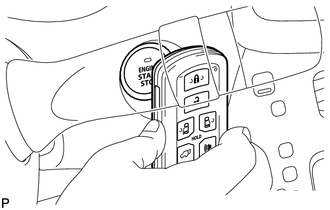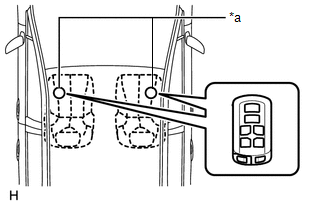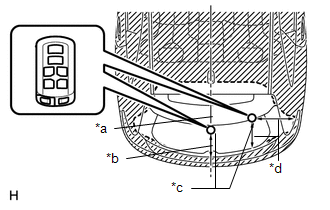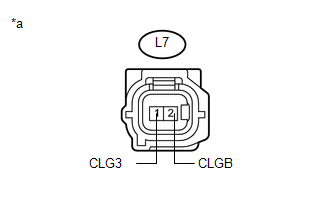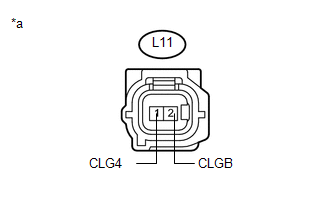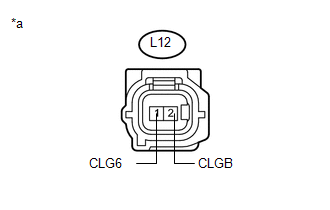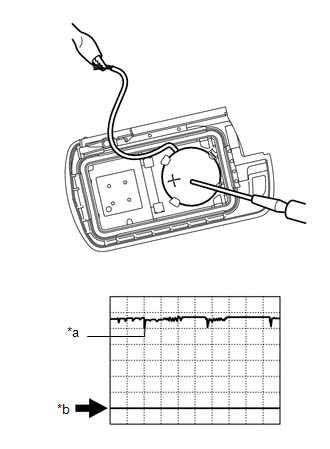- Engine switch off
- All doors closed
- Key not in cabin
- Door outside handle assembly (lock sensor) not touched
| Last Modified: 08-28-2024 | 6.11:8.1.0 | Doc ID: RM100000000VJKC |
| Model Year Start: 2016 | Model: Sienna | Prod Date Range: [12/2015 - ] |
| Title: THEFT DETERRENT / KEYLESS ENTRY: SMART KEY SYSTEM(for Entry Function): Room Oscillator does not Recognize Key; 2016 - 2020 MY Sienna [12/2015 - ] | ||
|
Room Oscillator does not Recognize Key |
DESCRIPTION
If the room oscillator does not recognize a key, one of the following may be the cause: 1) communication between the indoor electrical key oscillator (for front floor) and key cannot be performed; 2) communication between the indoor electrical key oscillator (for center floor) and key cannot be performed; or 3) communication between the indoor electrical key oscillator (for rear floor) and key cannot be performed.
WIRING DIAGRAM
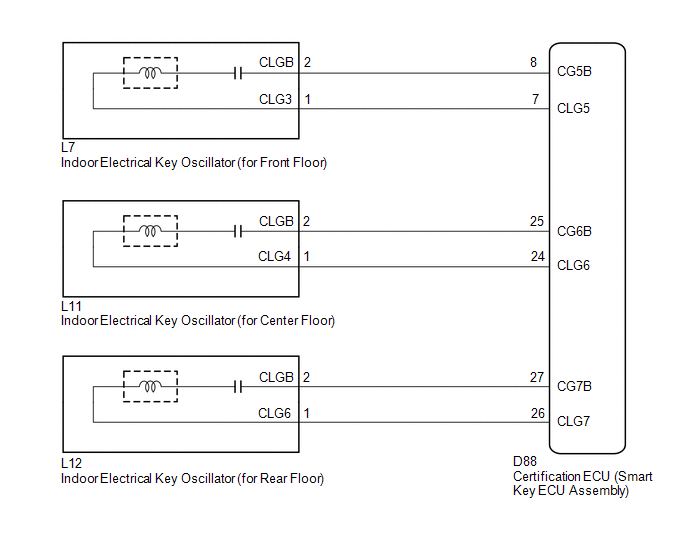
CAUTION / NOTICE / HINT
NOTICE:
-
The smart key system (for entry function) uses a multiplex communication system (LIN communication system) and CAN communication system. Inspect the communication function by following How to Proceed with Troubleshooting (See page
![2016 - 2020 MY Sienna [12/2015 - ]; THEFT DETERRENT / KEYLESS ENTRY: SMART KEY SYSTEM(for Entry Function): HOW TO PROCEED WITH TROUBLESHOOTING](/t3Portal/stylegraphics/info.gif) ). Troubleshoot the smart key system (for entry function) after confirming that the communication system is functioning properly.
). Troubleshoot the smart key system (for entry function) after confirming that the communication system is functioning properly.
- When using the Techstream with the engine switch off to troubleshoot: Connect the Techstream to the DLC3, and turn a courtesy light switch on and off at 1.5-second intervals until communication between the Techstream and vehicle begins.
PROCEDURE
|
1. |
CHECK SMART KEY SYSTEM (for Start Function) |
(a) Remove the battery of the key (See page
![2016 - 2020 MY Sienna [12/2015 - ]; DOOR LOCK: TRANSMITTER BATTERY(w/ Smart Key System): REPLACEMENT](/t3Portal/stylegraphics/info.gif) ).
).
|
(b) With the brake pedal depressed, touch the engine switch while facing the logo side of the key to the engine switch. |
|
(c) When operating the engine switch, check whether the power source mode changes.
OK:
Power source mode changes.
HINT:
- When the key cannot be verified even though it is within the specified range, the engine start check can be performed by removing the transmitter battery from the key and holding the transmitter close to the engine switch.
- When performing the check, if the power source mode changes, there is a problem with key certification inside the cabin.
| NG |

|
GO TO SMART KEY SYSTEM (for Start Function) (Proceed to How to Proceed with Troubleshooting) |
|
|
2. |
CHECK WAVE ENVIRONMENT |
(a) Install the battery to the key (See page
![2016 - 2020 MY Sienna [12/2015 - ]; DOOR LOCK: TRANSMITTER BATTERY(w/ Smart Key System): REPLACEMENT](/t3Portal/stylegraphics/info.gif) ).
).
(b) Bring the key near the indoor electrical key oscillator (for front floor), and check that the engine can be started.
NOTICE:
If the key is brought within 0.2 m (0.656 ft.) of the indoor electrical key oscillator (for front floor), communication is not possible.
(c) Bring the key near the indoor electrical key oscillator (for center floor), and check that the engine can be started.
NOTICE:
If the key is brought within 0.2 m (0.656 ft.) of the indoor electrical key oscillator (for center floor), communication is not possible.
(d) Bring the key near the indoor electrical key oscillator (for rear floor), and check that the engine can be started*.
*: If the customize setting for Ignition Available Area is not set ALL, the engine will not start. Before performing this inspection, check that ALL has been selected (See page
![2016 - 2020 MY Sienna [12/2015 - ]; THEFT DETERRENT / KEYLESS ENTRY: SMART KEY SYSTEM(for Entry Function): CUSTOMIZE PARAMETERS](/t3Portal/stylegraphics/info.gif) ).
).
NOTICE:
If the key is brought within 0.2 m (0.656 ft.) of the indoor electrical key oscillator (for rear floor), communication is not possible.
HINT:
- When the key is brought near the indoor electrical key oscillator, the possibility of wave interference decreases, and it can be determined if wave interference is causing the problem symptom.
- If the operation is normal, the possibility of wave interference is high. Also, added vehicle components may cause wave interference. If installed, remove them and perform the operation check.
OK:
The engine starts.
| OK |

|
AFFECTED BY WAVE INTERFERENCE |
|
|
3. |
PERFORM KEY DIAGNOSTIC MODE INSPECTION |
|
(a) Diagnostic mode inspection (indoor electrical key oscillator (for front floor)) Text in Illustration
(1) Connect the Techstream to the DLC3. (2) Turn the engine switch on (IG). (3) Turn the Techstream on. (4) Enter the following menus: Body Electrical / Smart Key / Key Communication Check / Overhead + Front Room. (5) When the key is placed on the driver seat or front passenger seat cushion, check that the wireless door lock buzzer sounds. |
|
|
(b) Diagnostic mode inspection (indoor electrical key oscillator (for center floor)) Text in Illustration
(1) Connect the Techstream to the DLC3. (2) Turn the engine switch on (IG). (3) Turn the Techstream on. (4) Enter the following menus: Body Electrical / Smart Key / Key Communication Check / Overhead + Rear Room. (5) When the key is placed on the rear seat cushion, check that the wireless door lock buzzer sounds. |
|
|
(c) Diagnostic mode inspection (indoor electrical key oscillator (for rear floor)) Text in Illustration
(1) Connect the Techstream to the DLC3. (2) Turn the engine switch on (IG). (3) Turn the Techstream on. (4) Enter the following menus: Body Electrical / Smart Key / Key Communication Check / Overhead + Back Door (inside). (5) When the key is held at the same height as the rear bumper upper surface and aligned with the center of the rear of the vehicle, check that the wireless door lock buzzer sounds. HINT: If the buzzer sounds, it can be determined that the indoor electrical key oscillators are operating normally. Result:
|
|
| B |

|
| C |

|
| D |

|
| E |

|
REPLACE CERTIFICATION ECU (SMART KEY ECU ASSEMBLY) |
|
|
4. |
CHECK HARNESS AND CONNECTOR (CERTIFICATION ECU - INDOOR ELECTRICAL KEY OSCILLATOR) |
(a) Disconnect the certification ECU (smart key ECU assembly) connector.
(b) Disconnect the indoor electrical key oscillator (for front floor) connector.
(c) Measure the resistance according to the value(s) in the table below.
Standard Resistance:
|
Tester Connection |
Condition |
Specified Condition |
|---|---|---|
|
D88-7 (CLG5) - L7-1 (CLG3) |
Always |
Below 1 Ω |
|
D88-8 (CG5B) - L7-2 (CLGB) |
Always |
Below 1 Ω |
|
D88-7 (CLG5) - Body ground |
Always |
10 kΩ or higher |
|
D88-8 (CG5B) - Body ground |
Always |
10 kΩ or higher |
|
L7-1 (CLG3) - Body ground |
Always |
10 kΩ or higher |
|
L7-2 (CLGB) - Body ground |
Always |
10 kΩ or higher |
| NG |

|
REPAIR OR REPLACE HARNESS OR CONNECTOR |
|
|
5. |
INSPECT INDOOR ELECTRICAL KEY OSCILLATOR (for Front Floor (INPUT)) |
|
(a) Reconnect the certification ECU (smart key ECU assembly) connector. |
|
(b) Check for pulses according to the value(s) in the table below.
OK:
|
Tester Connection |
Condition |
Specified Condition |
|---|---|---|
|
L7-1 (CLG3) - L7-2 (CLGB) |
|
No pulse generation |
|
L7-1 (CLG3) - L7-2 (CLGB) |
|
Pulse generation |
Text in Illustration
|
*a |
Front view of wire harness connector (to Indoor Electrical Key Oscillator (for Front Floor)) |
| NG |

|
REPLACE CERTIFICATION ECU (SMART KEY ECU ASSEMBLY) |
|
|
6. |
REPLACE INDOOR ELECTRICAL KEY OSCILLATOR (for Front Floor) |
(a) Replace the indoor electrical key oscillator (for front floor (See page
![2016 - 2020 MY Sienna [12/2015 - ]; THEFT DETERRENT / KEYLESS ENTRY: ELECTRICAL KEY OSCILLATOR(for Front Floor): REMOVAL](/t3Portal/stylegraphics/info.gif) ).
).
|
|
7. |
CHECK SMART KEY SYSTEM (ENTRY IGNITION FUNCTION (for Front Floor)) |
|
(a) Inspect the detection area for the entry ignition function (for front floor). Make sure that the direction of the key is as shown in the illustration. When the key is in either of the 2 inspection points shown in the illustration, check that the engine can start. Text in Illustration
OK: Engine starts normally. |
|
| OK |

|
END (INDOOR ELECTRICAL KEY OSCILLATOR WAS DEFECTIVE) |
| NG |

|
REPLACE CERTIFICATION ECU (SMART KEY ECU ASSEMBLY) |
|
8. |
CHECK HARNESS AND CONNECTOR (CERTIFICATION ECU - INDOOR ELECTRICAL KEY OSCILLATOR) |
(a) Disconnect the certification ECU (smart key ECU assembly) connector.
(b) Disconnect the indoor electrical key oscillator (for center floor) connector.
(c) Measure the resistance according to the value(s) in the table below.
Standard Resistance:
|
Tester Connection |
Condition |
Specified Condition |
|---|---|---|
|
D88-24 (CLG6) - L11-1 (CLG4) |
Always |
Below 1 Ω |
|
D88-25 (CG6B) - L11-2 (CLGB) |
Always |
Below 1 Ω |
|
D88-24 (CLG6) - Body ground |
Always |
10 kΩ or higher |
|
D88-25 (CG6B) - Body ground |
Always |
10 kΩ or higher |
|
L11-1 (CLG4) - Body ground |
Always |
10 kΩ or higher |
|
L11-2 (CLGB) - Body ground |
Always |
10 kΩ or higher |
| NG |

|
REPAIR OR REPLACE HARNESS OR CONNECTOR |
|
|
9. |
INSPECT INDOOR ELECTRICAL KEY OSCILLATOR (for Center Floor (INPUT)) |
|
(a) Reconnect the certification ECU (smart key ECU assembly) connector. |
|
(b) Check for pulses according to the value(s) in the table below.
OK:
|
Tester Connection |
Condition |
Specified Condition |
|---|---|---|
|
L11-1 (CLG4) - L11-2 (CLGB) |
|
No pulse generation |
|
L11-1 (CLG4) - L11-2 (CLGB) |
|
Pulse generation |
Text in Illustration
|
*a |
Front view of wire harness connector (to Indoor Electrical Key Oscillator (for Center Floor)) |
| NG |

|
REPLACE CERTIFICATION ECU (SMART KEY ECU ASSEMBLY) |
|
|
10. |
REPLACE INDOOR ELECTRICAL KEY OSCILLATOR (for Center Floor) |
(a) Replace the indoor electrical key oscillator (for center floor) (See page
![2016 - 2020 MY Sienna [12/2015 - ]; THEFT DETERRENT / KEYLESS ENTRY: ELECTRICAL KEY OSCILLATOR(for Center Floor): REMOVAL](/t3Portal/stylegraphics/info.gif) ).
).
|
|
11. |
CHECK SMART KEY SYSTEM (ENTRY IGNITION FUNCTION (for Center Floor)) |
|
(a) Inspect the detection area for the entry ignition function (for center floor). Make sure that the direction of the key is as shown in the illustration. When the key is in either of the 2 inspection points shown in the illustration, check that the engine can start. Text in Illustration
OK: Engine starts normally. |
|
| OK |

|
END (INDOOR ELECTRICAL KEY OSCILLATOR WAS DEFECTIVE) |
| NG |

|
REPLACE CERTIFICATION ECU (SMART KEY ECU ASSEMBLY) |
|
12. |
CHECK HARNESS AND CONNECTOR (CERTIFICATION ECU - INDOOR ELECTRICAL KEY OSCILLATOR) |
(a) Disconnect the certification ECU (smart key ECU assembly) connector.
(b) Disconnect the indoor electrical key oscillator (for rear floor) connector.
(c) Measure the resistance according to the value(s) in the table below.
Standard Resistance:
|
Tester Connection |
Condition |
Specified Condition |
|---|---|---|
|
D88-26 (CLG7) - L12-1 (CLG6) |
Always |
Below 1 Ω |
|
D88-27 (CG7B) - L12-2 (CLGB) |
Always |
Below 1 Ω |
|
D88-26 (CLG7) - Body ground |
Always |
10 kΩ or higher |
|
D88-27 (CG7B) - Body ground |
Always |
10 kΩ or higher |
|
L12-1 (CLG6) - Body ground |
Always |
10 kΩ or higher |
|
L12-2 (CLGB) - Body ground |
Always |
10 kΩ or higher |
| NG |

|
REPAIR OR REPLACE HARNESS OR CONNECTOR |
|
|
13. |
INSPECT INDOOR ELECTRICAL KEY OSCILLATOR (for Rear Floor (INPUT)) |
|
(a) Reconnect the certification ECU (smart key ECU assembly) connector. |
|
(b) Check for pulses according to the value(s) in the table below.
OK:
|
Tester Connection |
Condition |
Specified Condition |
|---|---|---|
|
L12-1 (CLG6) - L12-2 (CLGB) |
|
No pulse generation |
|
L12-1 (CLG6) - L12-2 (CLGB) |
|
Pulse generation |
Text in Illustration
|
*a |
Front view of wire harness connector (to Indoor Electrical Key Oscillator (for Rear Floor)) |
| NG |

|
REPLACE CERTIFICATION ECU (SMART KEY ECU ASSEMBLY) |
|
|
14. |
REPLACE INDOOR ELECTRICAL KEY OSCILLATOR (for Rear Floor) |
(a) Replace the indoor electrical key oscillator (for rear floor) (See page
![2016 - 2020 MY Sienna [12/2015 - ]; THEFT DETERRENT / KEYLESS ENTRY: ELECTRICAL KEY OSCILLATOR(for Rear Floor): REMOVAL](/t3Portal/stylegraphics/info.gif) ).
).
|
|
15. |
CHECK SMART KEY SYSTEM (ENTRY IGNITION FUNCTION (for Rear Floor)) |
|
(a) Inspect the detection area for the entry ignition function (for rear floor). Make sure that the direction of the key is as shown in the illustration. When the key is in either of the 2 inspection points shown in the illustration, check that the engine can start. Text in Illustration
OK: Engine starts normally. |
|
| OK |

|
END (INDOOR ELECTRICAL KEY OSCILLATOR WAS DEFECTIVE) |
| NG |

|
REPLACE CERTIFICATION ECU (SMART KEY ECU ASSEMBLY) |
|
16. |
CHECK TRANSMITTER BATTERY |
(b) Carefully pull the lead wire out from the position shown in the illustration and install the previously removed transmitter battery.
|
(c) Using an oscilloscope, check the transmitter battery voltage waveform. HINT: When measuring the battery voltage, while operating the lock switch of a door outside handle assembly, bring the key within the entry operating range to perform the measurement. For the entry operating range, refer to System Description (See page
Standard Voltage:
Text in Illustration
|
|
| NG |

|
|
|
17. |
CHECK ELECTRICAL KEY TRANSMITTER |
(a) Check if another registered key is available.
|
Result |
Proceed to |
|---|---|
|
Another registered key is not available. |
A |
|
Another registered key is available. |
B |
| B |

|
|
|
18. |
REGISTER ELECTRICAL KEY TRANSMITTER |
(a) Register a new key (See page
![2016 MY Sienna [12/2015 - 08/2016]; THEFT DETERRENT / KEYLESS ENTRY: ENGINE IMMOBILISER SYSTEM(w/ Smart Key System): REGISTRATION](/t3Portal/stylegraphics/info.gif)
![2017 - 2020 MY Sienna [08/2016 - ]; THEFT DETERRENT / KEYLESS ENTRY: ENGINE IMMOBILISER SYSTEM(w/ Smart Key System): REGISTRATION](/t3Portal/stylegraphics/info.gif) ).
).
|
|
19. |
CHECK ELECTRICAL KEY TRANSMITTER (OPERATION) |
(a) Using the key registered in the previous step or another registered key, check that the engine starts normally.
OK:
Engine starts normally.
| OK |

|
REPLACE ELECTRICAL KEY TRANSMITTER (REPLACE MALFUNCTIONING KEY) |
| NG |

|
REPLACE CERTIFICATION ECU (SMART KEY ECU ASSEMBLY) |
|
|
|
